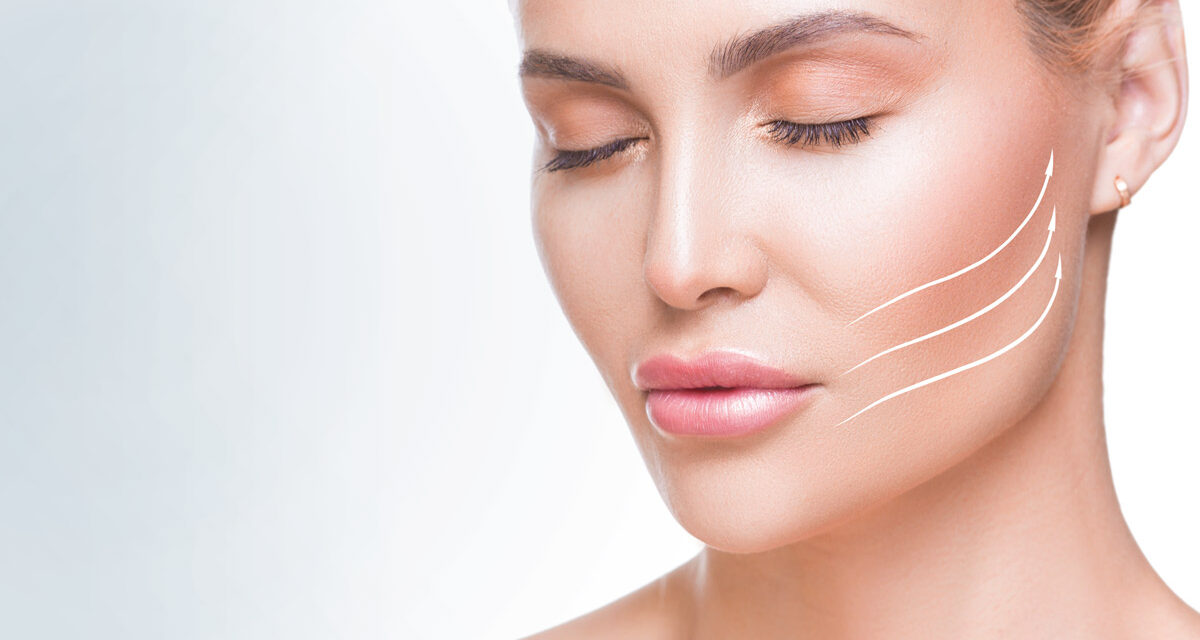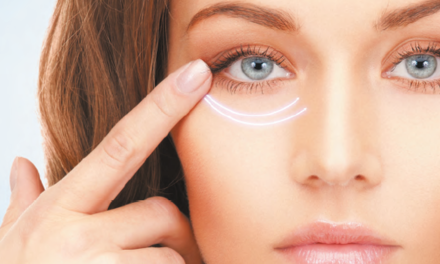George Sulamanidze, Lamzira Ebralidze, and Tamara Beshidze describe the lasting effects of the Visage Excellence Method in midface tissue suspension
Ageing results in facial fat loss, notably in the cheeks, eyes, jowls, and neck, accompanied by skin ageing marked by thinning elastic fibres and reduced facial elasticity1,2. These processes lead to facial elongation and wrinkle formation due to diminished support. Thread lifts, using surgical-grade threads or sutures, tighten and lift sagging facial areas, combat gravity and ageing effects, and provide facial rejuvenation3.
Polypropylene (PP) was among the first materials utilised in face-lifting sutures, known for its nonabsorbable characteristics, requiring more than a year to degrade fully4. This procedure is favoured by individuals seeking to address signs of ageing without undergoing traditional surgical face-lifts, as it typically involves less downtime and fewer risks. Aptos threads were one of the first threads used in aesthetic medicine1. In the 1980s, Sulamanidze introduced the first barbed thread for noninvasive aesthetic techniques2. Since then, absorbable alternatives such as polycaprolactone (PCL), polylactic acid (PLA), polyglycolic acid (PGA), and polydioxanone (PDO) have gained attraction in this field5.
Poly(L-lactide-co-ε-caprolactone) — P(LA/CL) — threads, composed of 75% polylactic acid and 25% polycaprolactone, incorporate bidirectional barbs to enhance tissue fixation and integration, resulting in a long-lasting effect6. P(LA/CL) threads can attribute their collagen-stimulating properties and superior strength to earlier generations7.
This article gives an overview of the principles of operation for the Aptos absorbable barbed threads — Visage Excellence. The Excellence line of Aptos threads includes six models: Visage Excellence Method (EV), Visage Excellence Method Soft, Nano Excellence Method, Visage Excellence Method with hyaluronic acid (HA), Visage Excellence Method Soft with HA, Nano Excellence Method with HA, and the Body Excellence Method. The models present three threads of different lengths, but all models have the same application layer, technique, and intended use (Table 1). Threads of different lengths are important to allow the most appropriate product to be used based on the size of the treated area, as wider faces would require longer threads. The different needles’ lengths and diameters were also adjusted to thread length. In addition, in the Excellence line, three models are coated with HA. HA is a biodegradable, non-immunogenic, and non-toxic glycosaminoglycan, an essential component of the extracellular matrix8. HA stimulates elastin and collagen, speeds up wound healing, and also reduces inflammation8. Below are the described principles of operation of the Visage Excellence Method — one of the widely known and used examples of Aptos barbed threads.
General principles of EV operation
The Visage Excellence Method (EV) utilises multiple pairs of opposing direction barbs to achieve repositioning and compression of subcutaneous tissue by grabbing and holding/fixing it in a repositioned site. Below is a description of the specific technological characteristics of the Visage Excellence Method.
Aptos barb
The Aptos barb is one of the principal technological features of the device that achieves adequate mechanical fixation of the threads in subcutaneous tissues. Variables such as the geometric shape, frequency, alignment, and sequence of Aptos barbs are optimised for use with subcutaneous fat tissue. The 19 cm thread contains a total of 56 single barbs, evenly distributed and organised into pairs through a specific arrangement.
The barb geometry, designed with the optimal dimensions (Figure 1), facilitates secure hooking onto the subcutaneous tissue, ensuring stable fixation. The barbs are strategically spaced at 2.5–5.0 mm on either side of a short retainer-free segment. The optimised cut depth of the Aptos barb primarily controls the base length and the bending rigidity of the barbs. Within the space formed between the barb and thread base, subcutaneous fat tissue is compressed, enhancing the thread’s holding strength at that precise point.
Aptos barb pattern/barb orientation
The Visage Excellence Method thread features 28 pairs of Aptos barbs that are evenly distributed along its entire length (Figure 2). Each pair comprises both the proximal and distal ends of a single barb, creating a mirror array of barbs in the opposite direction.
Upon insertion, the P(LA/CL) thread embeds subcutaneous fat tissue between 28 pairs of barbs distributed along its entire length. The proximal barbs reposit subcutaneous fat tissue in one direction (Figure 3), but distal barbs offer resistance when attempting to revert to their original position (Figure 4A). Being bidirectionally oriented, each pair of barbs effectively hooks onto the tissues, creating multiple fixating points within the treated area (Figure 4B).
Aptos barb surface area
Besides considering the optimal dimensions of Aptos barbs, the density of their placement along the thread’s length is crucial too. Threads with low barb density do not lift the same amount of tissue as those with a higher barb density. A greater contact area between the barbs and facial tissue demonstrated a more secure tissue hold. The proposed device boasts a carefully designed barb density, which maximises the contact surface area, ultimately promoting superior tissue integration. Table 2 below illustrates the total surface area of the barbs.
The Visage Excellence Method utilises 28 pairs of oppositely oriented Aptos barbs along the entire 190 mm length of each thread, totalling 56 single barbs. During the treatment procedure, one package, including 10 threads, is applied per patient, with five threads on each side of the midface. Consequently, a total of 560 single barbs (10 threads x 56 single barbs, equating to 280 pairs) reposit and hold the sagged tissue, covering an impressive surface area of 403.2 mm2.
The substantial surface area of the fixational units (barbs) ensures a more uniform distribution of loading forces over fixational points (pairs of barbs) along the thread, which provides the thread with an optimal holding capacity and minimises thread breakage.
Prolonged degradation profile of thread material: Poly-L-lactide-co-ε-caprolactone
EV offers an approach to suspend the midface subcutaneous tissue, temporarily holding it in an elevated position. The tissue holding capacity of the P(LA/CL) polymeric suture material is strongly determined by its degradation duration. To investigate the degradation profile of the Aptos thread, an in-vivo model has been utilised, and the results are visually depicted in the accompanying diagram (Figure 5)9,10. Notably, after 6 months of implantation, approximately 70% of the thread diameter remains intact in the implanted area. This finding further supports the expectation that the thread material maintains its integrity, providing sustained support to the tissue.
Summary of EV mode of action
EV achieves facial subcutaneous tissue elevation by effectively gripping and temporarily maintaining the tissue in an elevated position, employing multiple pairs/sets of opposing-direction barbs. Each pair of barbs involves bidirectionally/oppositely oriented single barbs, allowing the thread to maintain tissue fixation through the following principles:
Upon insertion, the proximal barb of each paired barb repositions descended (mobile) soft tissue, while the distal barb provides fixation and resists moving back to the original position
The insertion of multi-pair barbed thread ensures thread engagement with the tissue by bidirectional traction, reinforcing the thread-repositioning capability of the superficial fat compartment.
The Visage Excellence Method of utilising multiple pairs of bidirectionally/oppositely oriented barbs creates antagonistic traction between the barbs in two opposing directions. This balanced tension counteracts restoring forces and effectively keeps the thread elevated.
The degradation profile of the P(LA/CL) thread material ensures that both the thread itself and the barb retain their structural integrity to provide sustained support to the tissue.
Conclusions
The Visage Excellence Method (EV) utilising Poly-L-lactide-co-ε-caprolactone (P(LA/CL)) threads presents a successful approach for facial rejuvenation. Through meticulous analysis of its technological features and mechanisms, it becomes evident that EV with P(LA/CL) threads offer several advantages over traditional materials. The specialised design of Aptos barbs ensures effective tissue fixation, while the prolonged degradation profile of P(LA/CL) threads provides sustained support to the tissue over time. With their optimised thread configuration and superior strength, EV demonstrates enhanced tissue integration and long-lasting results, making it a preferred choice in midface tissue suspension procedures. Overall, the Visage Excellence Method is a notable advancement in facial rejuvenation techniques, offering patients and practitioners an effective and reliable solution for addressing age-related changes in facial contours.
Declaration of interest George Sulamanidze has ownership interest in medical products and techniques of Aptos LLC. Lamzira Ebralidze and Tamara Beshidze are employed at Aptos. The employment and ownership relationships have neither any interference with the activities and the results of this study nor the ability of the authors to process the reported material fairly, rationally and without any kind of bias.
Ethical Statement Study protocol and consent form used for the study were approved by the Ethics committee of the Clinic of Plastic and Aesthetic Surgery and Cosmetology “Total Charm Vake”, Tbilisi, Georgia.
Figures 1-5 © George Sulamanidze

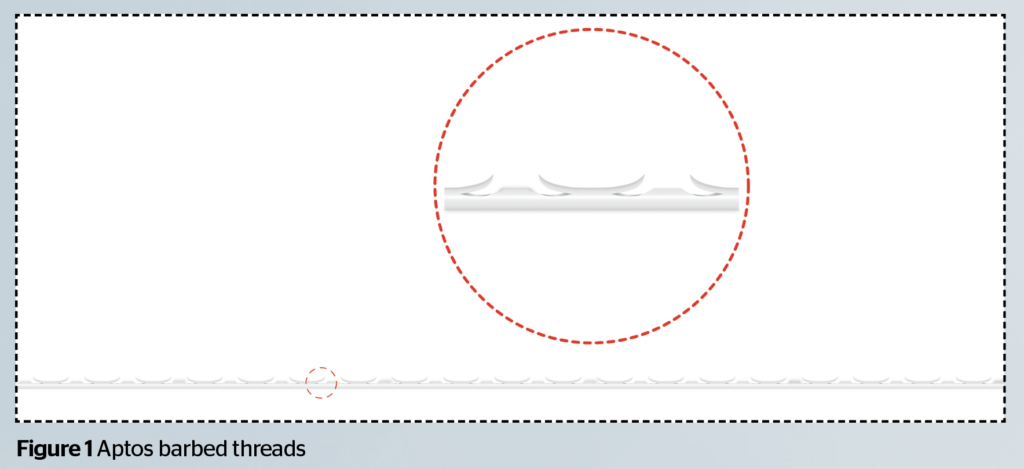
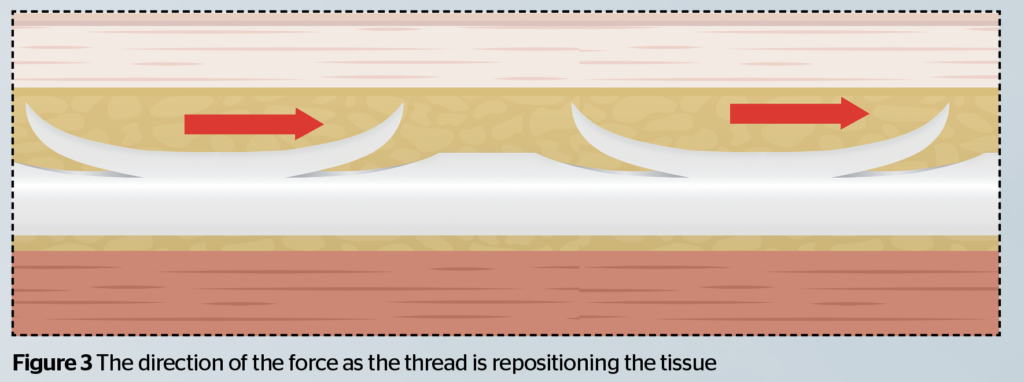
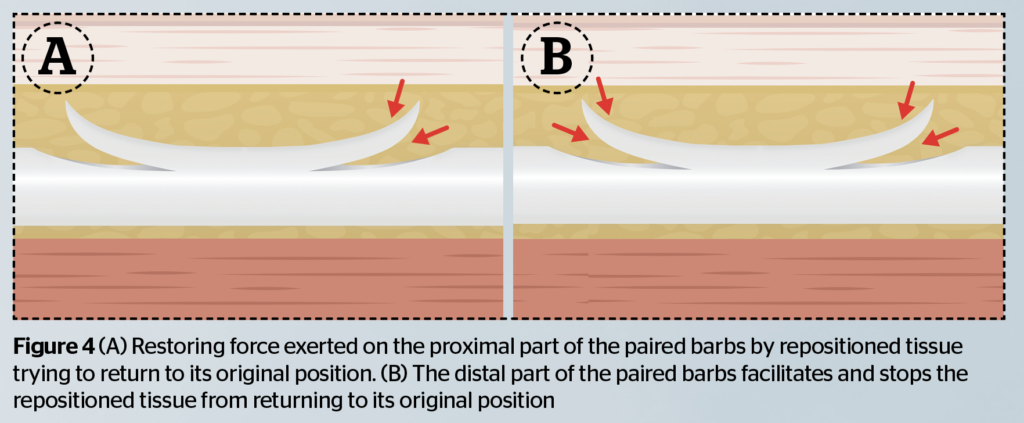
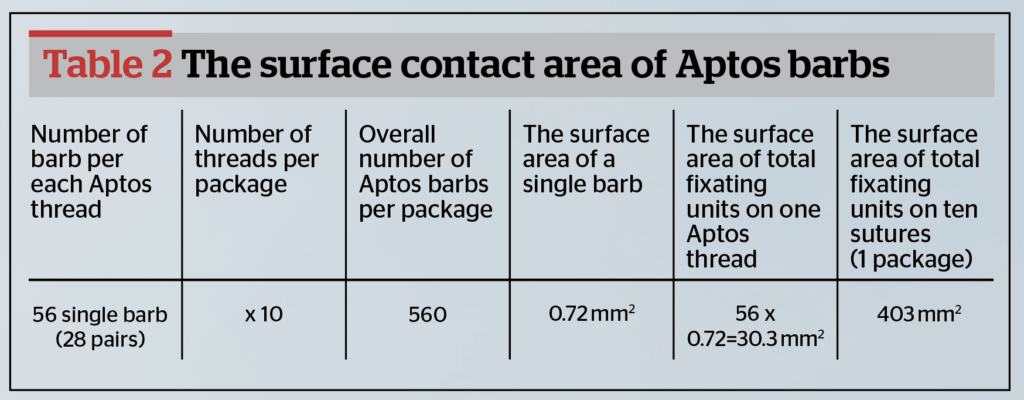
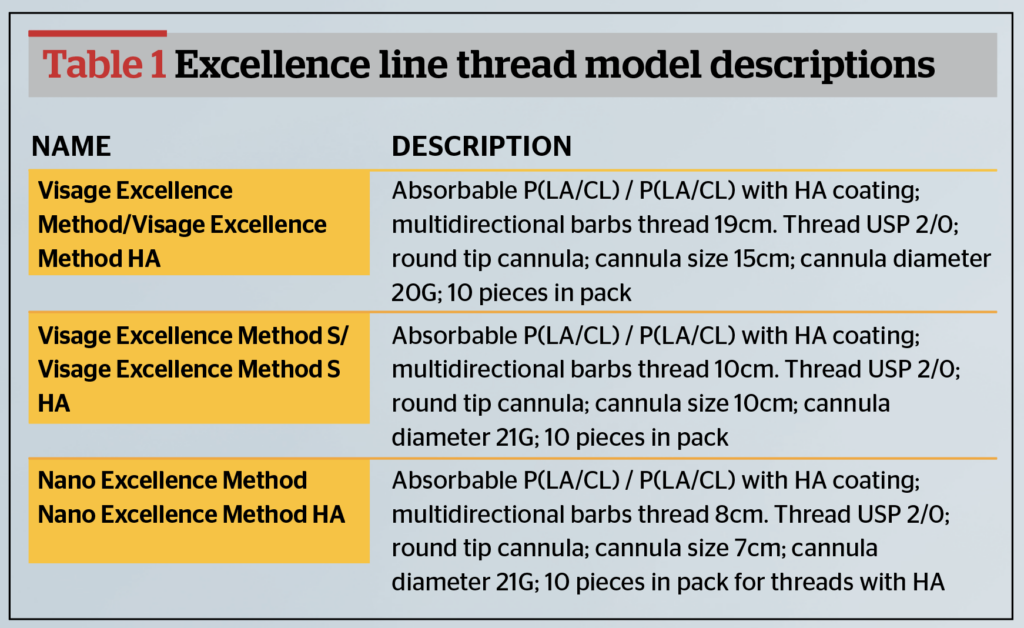
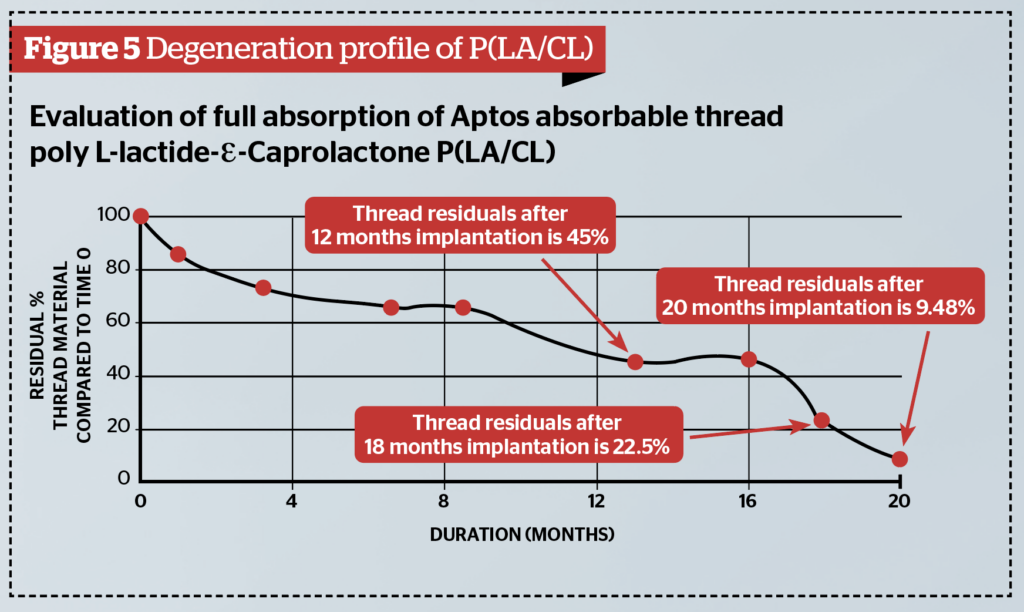
References
- Ilankovan V. Anatomy of ageing face. British Journal of Oral and Maxillofacial Surgery 2014;52(3):195-202.
- Sulamanidze MA, Paikidze TG, Sulamanidze GM, Neigel JM. Facial Lifting with “APTOS” Threads: Featherlift. Otolaryngologic Clinics of North America 2005;38(5):1109-1117.
- Garvey PB, Ricciardelli EJ, Gampper T. Outcomes in Threadlift for Facial Rejuvenation. Annals of Plastic Surgery 2009;62(5):482-485.
- Atiyeh BS, Dibo SA, Costagliola M, Hayek SN. Barbed sutures “lunch time” lifting: evidence-based efficacy. Journal of Cosmetic Dermatology 2010;9(2):132-141.
- Aitzetmueller MM, Cerdas CC, Nessbach P, et al. Polydioxanone threads for facial rejuvenation: analysis of quality variation in the market. Plast Reconstr Surg 2019; 144(6): 1002e-1009e.
- Zhukova O, Dydykin S, Kubíková E, Markova N, Vasil’ev Y, Kapitonova M. A New Complex Minimally Invasive Thread Lift Method for One-Time Three-Step Fixation of the Face and Neck Soft Tissues. Archives of Plastic Surgery 2022;49(3):296-303.;49:296–303.
- Wong V. The Science of Absorbable Poly(L-Lactide-Co-ε-Caprolactone) Threads for Soft Tissue Repositioning of the Face: An Evidence-Based Evaluation of Their Physical Properties and Clinical Application. Clinical, Cosmetic and Investigational Dermatology 2021;14:45-54.
- Ziade G, Daou D, Karam D, Tsintsadze M. The third generation barbed lifting threads: Added value of hyaluronic acid. Journal of Cosmetic Dermatology 2023;23(1):186-192.
- Sulamanidze GM, Sulamanidze MA, Sulamanidze KM, Kajaia AA, Giorgadze SG. The Subcutaneous Tissue Reaction on Poly (L-lactide-co-caprolactone) based Threads. International Journal of Clinical & Experimental Dermatology 2018;3(2):1-9.
- Beshidze T, Otkhozoria N. Physical properties of biodegradables and biologically compatibles copolymers after implantation until its complete resorption. Foundations and Trends in Modern Learning. 2023(2):235-244.
- Degradation and Local Tissue Response of Sutures in a Subcutaneous Rabbit Implant Model (GLP), Report Number: 98887, Performing Laboratory: Wuxi AppTec, USA
- Sulamanidze GM*. Sulamanidze MA. Sulamanidze KM. Kaidia AA. Gioraadze SG: ISSN: 24/6 – 2415 International Journal of Clinical & Experimental Dermatoloav 2018. The Subcutaneous issue Reactior on Polv (L-lactide-co-caprolactone) based Threads.Case Report

